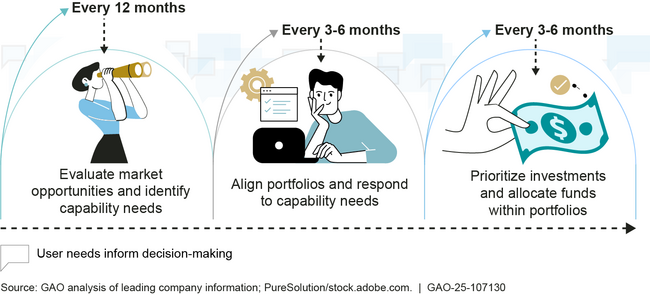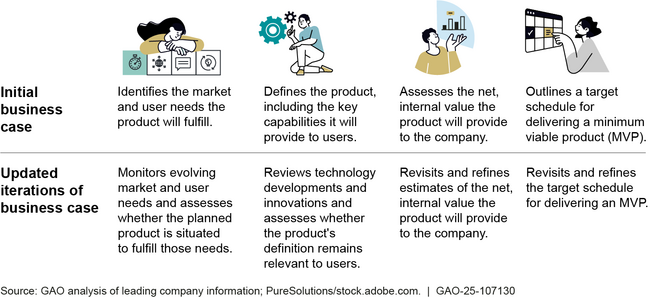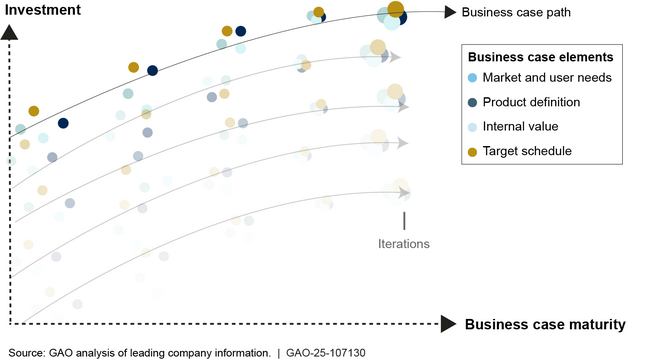Leading Practices: Agile Portfolio Management and Iterative Business Cases Drive Innovative Product Development
Fast Facts
Leading companies want their business processes to be as cutting edge as the tech they use to develop innovative products. To ensure they quickly respond to users' needs, they:
Manage products through recurring processes, such as updating portfolios (sets of related products) to respond to user needs at least every 6 months
Continually update a product's business plan as they gain knowledge from user feedback and new data
Federal agencies can learn from these approaches to help them deliver innovative capabilities—such as battlefield command enabled with artificial intelligence—faster and better. Our report outlines these leading practices.

A photo of hands typing on a laptop computer with illustrations of charts and graphs superimposed on the space above the hands
Highlights
Why This Matters
For over 25 years, GAO has recommended actions that the Department of Defense and other federal agencies should take to improve their most complex and costly acquisition programs, saving taxpayers tens of billions of dollars. Most recently, this work has emphasized structuring acquisition programs around iterative development—a process stemming from Agile software development that leading companies use to develop innovative, value-added products that respond quickly to users’ needs. Such leading practices offer proven approaches that can inform improvements to agencies’ acquisition of complex systems.
A sound technical process is not the only driver for the consistent pattern of success that characterizes leading companies’ product development. Leading companies employ equally robust business processes to initiate, justify, and prioritize their investments in innovative products such as semiconductors and industrial automation systems.
Key Takeaways
Leading companies employ a forward-looking, agile approach to managing the overall mix of products, or product portfolios, through recurring processes.
Leading Companies Manage Product Portfolios Through Recurring Processes

Leading companies continually interact with business cases—collections of information that justify undertaking product development efforts. For example, based on regular assessments of business case data, portfolio managers may decide to add resources to improve weaker performing products or discontinue outdated products that impede demand for updated versions. Continually updating portfolios based on business case data enables leading companies to optimize their investments and ensure portfolios are responsive to the company’s strategic vision and evolving user needs.
Leading companies also apply an iterative process to developing their business cases for individual products. This is a departure from the traditional business case process that locks in a new product’s cost, schedule, and performance baseline from the start. As they gain knowledge, leading companies continually improve the business case for a new product and update key elements to capture changes in user needs, technology readiness, and markets.
Leading Companies Iteratively Develop Business Cases

Leading companies systematically reassess business cases’ key elements—market and user needs, product definition, internal value, and target schedule—at least every 6 months to avert problems sooner. They make investments only as products demonstrate progress and business cases warrant further funding. For example, they reserve the largest allocations until they have validated a design for the minimum viable product—one that includes the minimum capabilities needed for customers to recognize value.
Leading Companies Scale Investment as the Business Case Evolves

How GAO Did This Study
This report is the third of a series on product development leading practices—preceded by GAO-22-104513 and GAO-23-106222—and responds to three congressional reports with requests related to acquisition leading practices, portfolio management, and requirements. It examines the practices selected leading companies employ to guide product development investments. GAO identified eight companies based on rankings in well-recognized lists, interviewed company representatives, and analyzed documentation.
For more information, contact Shelby S. Oakley at oakleys@gao.gov.
